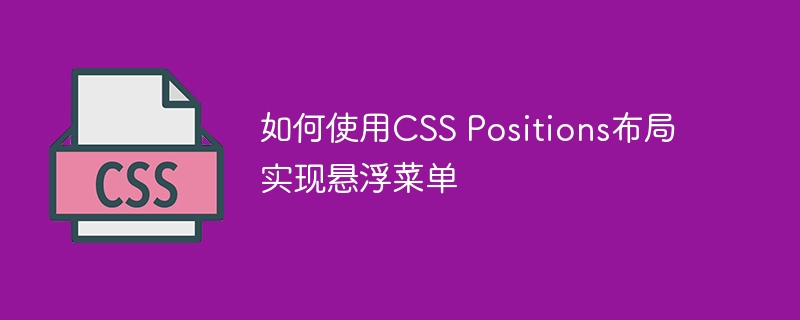Home >Web Front-end >CSS Tutorial >How to implement a floating menu using CSS Positions layout
How to implement a floating menu using CSS Positions layout
- WBOYWBOYWBOYWBOYWBOYWBOYWBOYWBOYWBOYWBOYWBOYWBOYWBOriginal
- 2023-09-27 20:21:421093browse

How to use CSS Positions layout to implement a floating menu
In web design, the floating menu is a common layout method, which can make the menu bar appear when the page scrolls. Keeps the position fixed and does not disappear as the page scrolls. This effect can increase the usability and user experience of web pages. In this article, we will introduce how to use CSS Positions layout to implement a floating menu and provide specific code examples.
The core idea of the floating menu is to use the position property of CSS to control the position of the menu. Commonly used position attribute values include static, relative, absolute and fixed. Among them, relative means relative positioning, the position of the element in the document flow remains unchanged; absolute means absolute positioning, the element is positioned relative to the nearest non-statically positioned parent element or body element; fixed means fixed positioning, the element is positioned relative to the browser window .
The following is a simple HTML structure example:
<!DOCTYPE html>
<html>
<head>
<link rel="stylesheet" type="text/css" href="styles.css">
</head>
<body>
<header>
<nav class="navbar">
<ul>
<li><a href="#">菜单项1</a></li>
<li><a href="#">菜单项2</a></li>
<li><a href="#">菜单项3</a></li>
<li><a href="#">菜单项4</a></li>
</ul>
</nav>
</header>
<div class="content">
<!-- 页面内容 -->
</div>
<script src="script.js"></script>
</body>
</html>The following is the corresponding CSS style:
body {
margin: 0;
padding: 0;
}
.navbar {
position: fixed;
top: 0;
left: 0;
width: 100%;
background-color: #333;
color: #fff;
padding: 10px;
}
.navbar ul {
list-style-type: none;
margin: 0;
padding: 0;
}
.navbar li {
display: inline-block;
margin-right: 10px;
}
.navbar li a {
color: #fff;
text-decoration: none;
}In the above code, we set the position of .navbar to fixed to position it fixedly relative to the browser window. Use the top and left properties to set the menu's initial position. The width attribute sets the width of the menu, the background-color and color attributes set the background color and text color of the menu, and the padding attribute is used to set the spacing between menu items.
With the above code, we can implement a simple floating menu. The menu will always remain at the top of the browser window as the page scrolls.
It should be noted that the floating menu may block part of the page content. In this case, a certain amount of upper and lower padding needs to be added to the content area to prevent the content from being blocked by the menu.
I hope this article can help you understand how to use CSS Positions layout to implement a floating menu. If you have any questions, please feel free to ask.
The above is the detailed content of How to implement a floating menu using CSS Positions layout. For more information, please follow other related articles on the PHP Chinese website!

